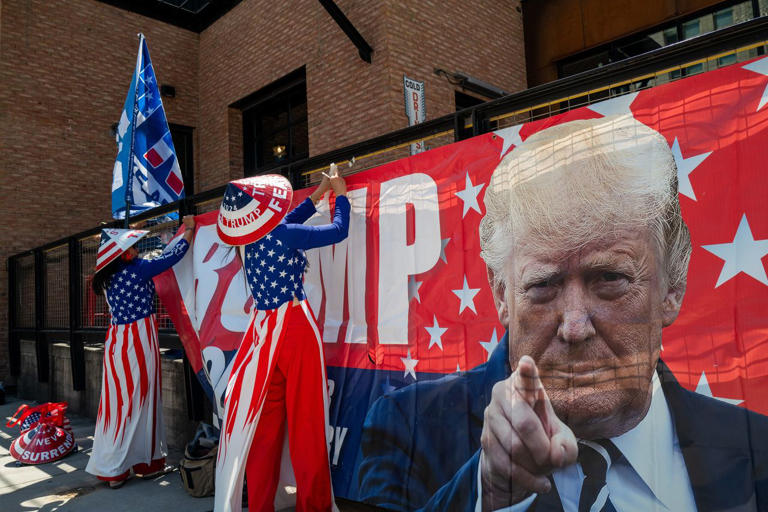In recent months, financial markets have shown a pronounced focus on thematic trading, particularly influenced by the potential outcomes of major political events like the 2024 U.S. Presidential election. Investors have crafted a detailed playbook based on previous experiences, particularly drawing from the 2016 election cycle, to anticipate how a potential Donald Trump presidency might impact the markets. However, the effectiveness of this strategy in today’s rapidly evolving economic and political landscape raises important questions.
For much of 2024, the spotlight in financial markets has been on the dramatic growth of artificial intelligence (AI) and the megacorporations driving its advancement. This sector’s rise has led to significant investments and trading activity centered around tech giants and their role in AI innovation. However, the market dynamics shifted abruptly when the Russell 2000 index, representing small-cap stocks, experienced a remarkable surge of 10% on a single day. This marked the index’s strongest weekly performance against the Russell 1000, which includes larger, more established firms. At the same time, the technology-focused Nasdaq saw its largest one-day percentage decline since December 2022, while traditionally undervalued “value” stocks enjoyed a rebound.
This recent market shift bears resemblance to the response following Trump’s unexpected victory in the 2016 Presidential election. At that time, Wall Street had anticipated that Trump’s protectionist policies and a potential trade war would lead to a market selloff. Contrary to these expectations, the market rallied, buoyed by the anticipation of tax cuts and deregulation. This rally led to the emergence of what is now known as the “Trump trade.” The essence of this trade was to buy stocks, pivot towards smaller, domestically oriented companies and traditional industries, and adjust positions in bonds, currencies, and other assets based on anticipated policy changes.
The recent rotation in the market, driven by an encouraging inflation report, has once again brought the “Trump trade” into focus. This report led investors to anticipate more interest rate cuts, causing Treasury yields to decrease and the U.S. dollar to weaken. Despite this, Trump’s recent political developments, including surviving an assassination attempt and gaining a growing lead in polls, have significantly influenced market sentiment.
The volatility of the Mexican peso has surged to its highest levels since 2020, reflecting concerns about potential political and economic instability. International markets have faced challenges despite periods when value stocks typically outperform. For instance, Eurozone equities experienced a brief surge on July 12, only to underperform in the following days. Domestically, sectors such as energy, manufacturing, and finance, especially regional banks, have performed well due to expectations of reduced regulatory scrutiny and the potential for higher interest rates.
However, the application of the 2016 “Trump trade” strategies to the current market environment is not straightforward. Several factors differentiate the current context from that of 2016. For one, Trump’s position on cryptocurrencies has evolved, with increased support contributing to the rise in bitcoin prices. Additionally, Trump’s endorsements from prominent figures like Tesla CEO Elon Musk and his vice presidential pick, JD Vance, who has connections to Silicon Valley, add layers of complexity to the market’s response.
The potential implications for electric-vehicle manufacturers like Tesla under a Trump presidency are uncertain. While a Republican administration might offer protection against Chinese competition, it could also reduce support for domestic electric-vehicle makers. Retail trading in Tesla shares has surged, but there is a notable balance between buying and selling, reflecting investor uncertainty.
Similarly, Big Tech companies could benefit from a potential reduction in antitrust enforcement under a Trump administration compared to the Biden administration. On the other hand, oil and gas companies might experience a windfall from lower environmental regulations, but this could be offset by a production surplus.
Moreover, the economic context has changed significantly since 2016. The current budget deficit is much larger, and corporate tax rates have already been reduced from 35% to 21% by the Tax Cuts and Jobs Act of 2017. Trump’s proposed further reduction to 20% might have a less pronounced impact. Additionally, the potential tariff increases proposed by Trump could have a more significant effect given the protectionist measures inherited from Biden’s presidency.
It is also important to consider that the initial “Trump trade” did not necessarily yield the best outcomes for investors. While tax cuts provided a temporary boost to the stock market in 2018, the benefits were largely concentrated among the largest companies, with the tech sector being a primary beneficiary. The Russell 2000’s outperformance immediately following the 2016 election was short-lived. Despite a brief revival in 2018, small-cap stocks, along with sectors such as industrials and energy, underperformed compared to the broader S&P 500 during Trump’s presidency. In the end, technology stocks emerged as the standout performers.
The broader takeaway is that profiting from political events is complex and often overshadowed by larger, more persistent economic trends. While the “Trump trade” offers a framework for understanding potential market moves, it is crucial for investors to recognize that trading strategies based on political outcomes differ from comprehensive, well-founded investment approaches. Navigating the market’s response to political events requires a nuanced understanding of both current conditions and historical precedents, making it essential for investors to adapt their strategies to the evolving economic and political landscape.
